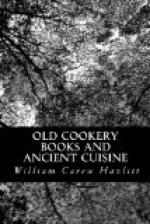In the fifteenth century the existing stock of fish for culinary purposes received, if we may trust the vocabularies, a few accessions; as, for instance, the bream, the skate, the flounder, and the bake.
In “Piers of Fulham (14th century),” we hear of the good store of fat eels imported into England from the Low Countries, and to be had cheap by anyone who watched the tides; but the author reprehends the growing luxury of using the livers of young fish before they were large enough to be brought to the table.
The most comprehensive catalogue of fish brought to table in the time of Charles I. is in a pamphlet of 1644, inserted among my “Fugitive Tracts,” 1875; and includes the oyster, which used to be eaten at breakfast with wine, the crab, lobster, sturgeon, salmon, ling, flounder, plaice, whiting, sprat, herring, pike, bream, roach, dace, and eel. The writer states that the sprat and herring were used in Lent. The sound of the stock-fish, boiled in wort or thin ale till they were tender, then laid on a cloth and dried, and finally cut into strips, was thought a good receipt for book-glue.
An acquaintance is in possession of an old cookery-book which exhibits the gamut of the fish as it lies in the frying-pan, reducing its supposed lament to musical notation. Here is an ingenious refinement and a delicate piece of irony, which Walton and Cotton might have liked to forestall.
The 15th century Nominale enriches the catalogue of dishes then in vogue. It specifies almond-milk, rice, gruel, fish-broth or soup, a sort of fricassee of fowl, collops, a pie, a pasty, a tart, a tartlet, a charlet (minced pork), apple-juice, a dish called jussell made of eggs and grated bread with seasoning of sage and saffron, and the three generic heads of sod or boiled, roast, and fried meats. In addition to the fish-soup, they had wine-soup, water-soup, ale-soup; and the flawn is reinforced by the froise. Instead of one Latin equivalent for a pudding, it is of moment to record that there are now three: nor should we overlook the rasher and the sausage. It is the earliest place where we get some of our familiar articles of diet—beef, mutton, pork, veal—under their modern names; and about the same time such terms present themselves as “a broth,” “a browis,” “a pottage,” “a mess.”




